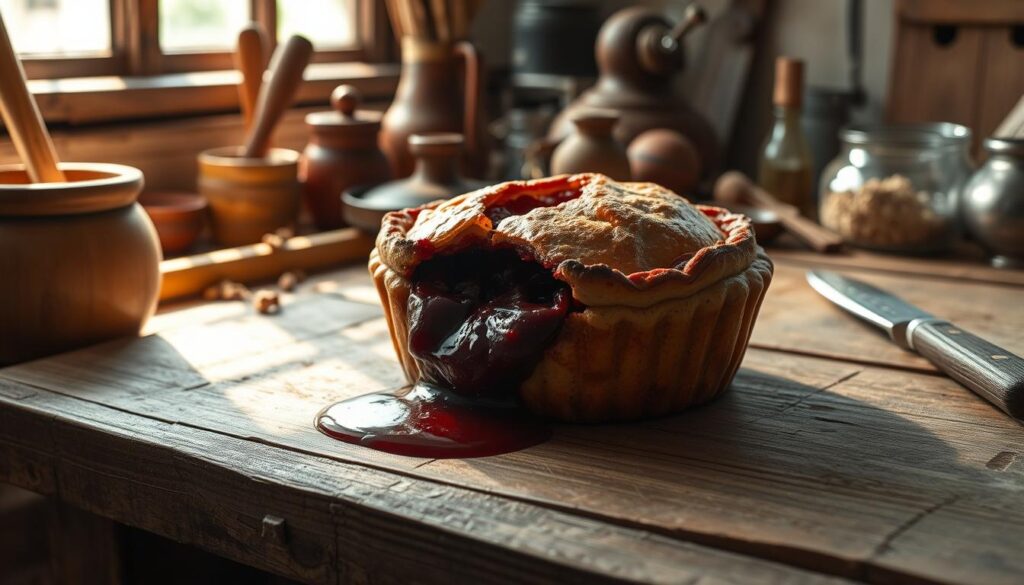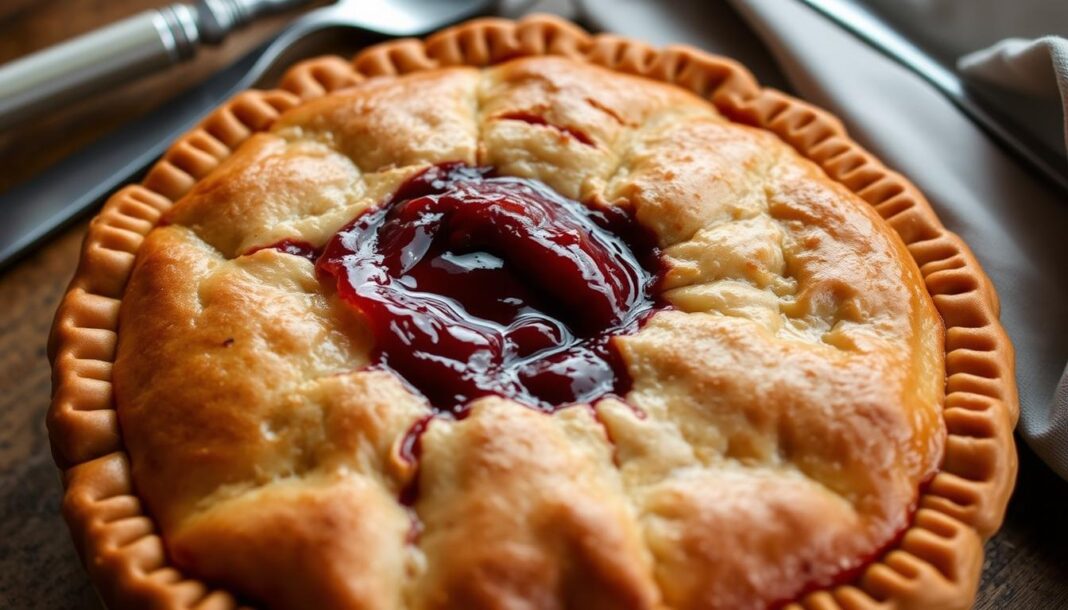We often look to science fiction for culinary inspiration, and one dish that has captured the imagination of fans is the Rokeg blood pie from Star Trek. However, the concept of blood pie is rooted in history, not fiction. Blood has been a staple ingredient in various cuisines, used in soups, sauces, and even as a thickening agent.
Comprised of roughly 80% water and 17% protein, blood thickens at 167 degrees F due to the denaturing of the albumin protein. This property makes it a valuable ingredient in cooking. In this guide, we’ll explore traditional blood pie recipes and modern alternatives, delving into the science behind cooking with blood and its unique nutritional properties.
Key Takeaways
- Explore the historical context of blood pie and its appearance in popular culture.
- Understand the science behind cooking with blood, including its thickening properties.
- Discover traditional blood pie recipes and modern alternatives.
- Learn about the nutritional properties of blood as a cooking ingredient.
- Get a step-by-step guide to making your own blood pie or its alternatives.
The Fascinating History of Blood Pie
With roots in ancient culinary practices, blood pie has evolved into a dish with diverse cultural significance. The use of blood in cooking is a tradition that spans many cultures, often symbolizing strength, vitality, and community bonding.
Blood as a Traditional Ingredient
Blood has been a traditional ingredient in many cuisines, used to add depth and richness to various dishes. Blood-based recipes are found in European, Asian, and Latin American culinary traditions, showcasing the versatility of blood as an ingredient. For instance, blood sausage and blood pudding are popular in many cultures.
Klingon Rokeg Blood Pie in Star Trek
The Star Trek universe introduced the concept of Rokeg Blood Pie as a traditional Klingon delicacy, consumed during the Day of Honor. This fictional dish reflects real-world traditions where blood-based foods carry symbolic meaning. Lt. Commander Worf’s fondness for this dish connects him to his Klingon heritage, illustrating the cultural significance of food in the show
Making Blood Pie: Traditional vs. Modern Approaches
The art of crafting blood pie has evolved, offering both authentic and contemporary interpretations. We explore the traditional methods and modern alternatives, providing a comprehensive guide for those interested in making this unique dish.
Authentic Blood Preparation Techniques
Traditionally, blood pie is made with real blood, as seen in the Klingon staple, Rokeg Blood Pie. To prepare blood for cooking, it’s essential to handle it safely to avoid contamination. Proper preparation involves mixing the blood with other ingredients like onions and spices to enhance the flavor. The mixture is then cooked until it reaches the desired consistency.
Blood-Free Alternatives Using Beets and Squash
For those who prefer not to use actual blood, modern recipes offer alternatives using beets and butternut squash. We can create a similar deep red color and rich flavor profile by roasting beets and squash in the oven with olive oil, sage, garlic powder, salt, pepper, and parsley. The roasted vegetables are then mixed with sautéed onions and mushrooms to create a savory filling.
| Ingredient | Traditional Use | Modern Alternative |
|---|---|---|
| Blood | Used as the primary ingredient | Replaced with beets for color and flavor |
| Onions | Mixed with blood for added flavor | Sautéed with mushrooms for depth of flavor |
| Squash | Not typically used | Used to add creamy texture |

Step-by-Step Blood Pie Recipe
With our historical and methodological groundwork laid, let’s move on to crafting our very own Blood Pie. This recipe combines traditional techniques with modern alternatives to create a dish that’s both authentic and accessible.
Ingredients You’ll Need
To make a Blood Pie, you’ll need a variety of ingredients, including vegetables, meats, and spices. Some of the key components include potatoes, bacon, sausage, and beets, which provide a rich and savory flavor profile. For those looking for a blood-free alternative, beets can be used to create a similar color and texture.
Preparing the Vegetables and Meats
Begin by preparing your vegetables and meats. This involves roasting the beets and cooking the bacon and sausage until they’re crispy. These components will be mixed together with the potatoes to create the filling.
Creating the Perfect Crust
The crust is a crucial element of the Blood Pie. To create a flaky and golden crust, you’ll need to combine flour, butter, and water, then chill the mixture before rolling it out. The crust should be partially baked before adding the filling.
Assembly and Baking Instructions
To assemble the pie, pour the prepared filling mixture into the partially baked crust, ensuring an even distribution throughout the pan. Reserve some of the more visually appealing components, like roasted beets and bacon, to arrange on top of the mixture. Return the pie to the oven to finish baking for 10-15 minutes or until the potato mix layer is hot and the edge of the crust is firm and lightly brown.
During the final baking phase, monitor the crust closely to prevent overbrowning. If necessary, wrap some tin foil over the edge to protect it. The pie is ready when the filling is hot throughout and the crust is firm to the touch with a light brown color.
Enjoying Your Blood Pie Creation
The culmination of our culinary journey is here – serving and savoring the blood pie. Serve it hot to a hungry Klingon warrior, and you’ll witness a delightful experience. The blood and meat custard filling offers a slight resistance to the teeth but yields to the tongue, imparting a rich, tantalizing umami flavor with a subtle hint of sweetness.
The contrast between the flaky crust and the rich, savory filling creates a delightful eating experience. Our completed blood pie is best served warm, much like the Rokeg Blood Pie enjoyed by Klingons in Star Trek. The top layer, with its arranged vegetables and meats, adds visual appeal.
- The complex flavors and textures reach their optimal state when served warm.
- The alternative recipe achieves a similar depth of flavor to traditional blood pies through carefully selected ingredients.
- Exploring traditional dishes like Swedish blood pudding or British black pudding can provide further insights into historical blood-based recipes.
Whether you’re preparing this dish for a themed gathering or out of culinary curiosity, creating blood pie connects us to food traditions that span time, cultures, and even fictional universes. We hope you’ve enjoyed this culinary adventure with us.


